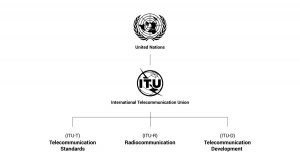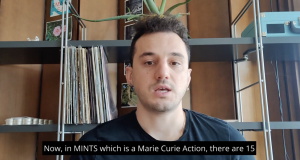Published on: Jan 30, 2021
Welcome to Part 4 of our MINTS 101 series, where we discuss the different technical aspects of the MINTS project. We have already covered the basics of mmWave technology, its applications, the history behind 5G, and its benefits. You probably have noticed that several technical requirements and features mentioned in the blogs refer to technical documents from international organizations. These international organizations are behind unified technology development. They keep track of and update the documents regularly so that there is a universal understanding and agreement on research and production advancement. This process is referred to as standardization. Universal agreement is the only way for all devices to properly establish adequate communication, hence the importance of standardization.
We will introduce two of the most important organizations behind the development of 5G in this blog: the International Telecommunication Union (ITU) and the 3rd Generation Partnership Project (3GPP). We then move forward to understand how progress is engraved into the main blueprint for 5G technology: the 3GPP Technical Specifications (TSs), colloquially referred to as standards.
ITU
The International Telecommunication Union, as they define themselves, “is the United Nations (UN) specialized agency for information and communication technologies (ICTs)”. Founded in 1865 and administered by the UN since then, it allocates global radio spectrum and satellite orbits, produces technical standards, and commits to initiatives that connect all the world’s people [1]. ITU is divided into three Sectors that correspond to three main areas of activity: Radiocommunication Sector (ITU-R), Telecommunication Standardization Sector (ITU-T) and Telecommunication Development Sector (ITU-D).

Fig. 1. ITU’s Organizational Chart [2]
All the sectors produce highly reputable technical standards or guidelines called Recommendations. They are conceived by experts in the field around the world, who guarantee high quality and international applicability. Thanks to it, they are usually adopted internationally [3].
More specifically, ITU-R Recommendations provide a list of requirements for a radiocommunication proposal to be accepted as a contribution to the world. These requirements or specifications are referred to as International Mobile Telecommunications (IMT) standards. IMT-2000 and IMT-Advanced defined the requirements for mobile broadband technologies, usually known as 3G and 4G. IMT-2020 defines the requirements for 5G technologies. Standardization bodies and ITU Member States can submit technology proposals that comply with IMT standards to ITU-R. Among submissions for IMT-2020, there are proposals from 3GPP, the European Telecommunications Standards Institute (ETSI), the Telecommunications Standards Development Society India (TSDSI), and China and Korea as Member States [4].
3GPP and Proposal Submission
The 3rd Generation Partnership Project (3GPP) is the most dominant communication technology project – standardization body in other words – unifying seven telecommunication standards development organizations and providing an adequate environment to develop globally accepted communication standards [5]. Its seal guarantees that a product meets the highest requirements in many terms and can be safely distributed. As mentioned in “MINTS 101: Part 3”, the third generation (3G) of cellular technology began to be developed by 3GPP, inspired by the idea of unified progress based on second-generation (2G) cellular technology. From there, 3GPP has been carrying progress towards 4G and currently, 5G. There are three main branches of research, called Technical Specification Groups (TSGs), namely Radio Access Networks (RAN), Services & Systems Aspects (SA), and Core Network & Terminals (CT). Each TSG is subdivided into Working Groups (WGs) that meet regularly and come together for quarterly TSG Plenary meetings where work is presented, discussed, and approved or rejected. These meetings are planned well ahead and hosted all over the world. They help organize technology development at a timely pace.
ITU-R and 3GPP then interact through proposal submissions to shape the future of telecommunications in terms of technology. Roughly speaking, 3GPP submits the technical 5G proposal for IMT-2020 to ITU-R in given deadlines, and ITU-R reviews and approves it in a continuous cycle [2].
Inside 3GPP Meetings
Now the question is, how does 3GPP include new technology into the technical 5G standards from the meetings? Well, it turns out it is a hectic and competitive process where every affiliated individual organization wants to share contributions to the big technology proposal to be submitted – currently 5G. The process is organized in well-planned plenary meetings held all over the world.

Fig. 2. Typical Setting of a Plenary 3GPP Meeting [6]
Months of research have to be packed into concise presentations for 3GPP meetings, a couple of minutes at most. A particular study would only be worth a few lines into the documents that are part of the technical proposal, the Technical Specifications (TSs). Acceptance or rejection of the contribution is democratically done among the participants. If the verdict is not clear, the contribution might be further discussed or delayed for months. The amount of presentations is so massive, that numerous proposals will be accepted at one meeting despite countless rejections. This approach enables non-stop technology progress.
By researching areas that still need exploring, MINTS aims to contribute to communication technologies such as 5G. Direct or indirect contribution to 5G standards may be included in the process.
If you were able to stick until the end and can’t wait for more content and want to know about us and our projects, you can always follow our social media channels.
Citations
[1] ITU, About International Telecommunication Union. Accessed on: Jan. 18, 2021. [Online]. Available: https://www.itu.int/en/about/Pages/default.aspx
[2] V. Shao, 5G: The Complicated Relationship Between ITU and 3GPP, Medium. Accessed on: Jan. 18, 2021. [Online]. Available: https://medium.com/swlh/5g-the-complicated-relationship-between-itu-and-3gpp-719938f42b8
[3] ITU, What does ITU do? Accessed on: Jan. 18, 2021. [Online]. Available: https://www.itu.int/en/about/Pages/whatwedo.aspx
[4] ITU, ITU-R FAQ on International Mobile Telecommunications (IMT). Accessed on: Jan. 18, 2021. [Online]. Available: https://www.itu.int/en/ITU-R/Documents/ITU-R-FAQ-IMT.pdf
[5] 3GPP, About 3GPP. Accessed on: Jan. 18, 2021. [Online]. Available: https://www.3gpp.org/about-3gpp
[6] Qualcomm, 3GPP Charts the Next Chapter of 5G Standards. Accessed on: Jan. 18, 2021. [Online]. Available: https://www.qualcomm.com/news/onq/2019/12/13/3gpp-charts-next-chapter-5g-standards





